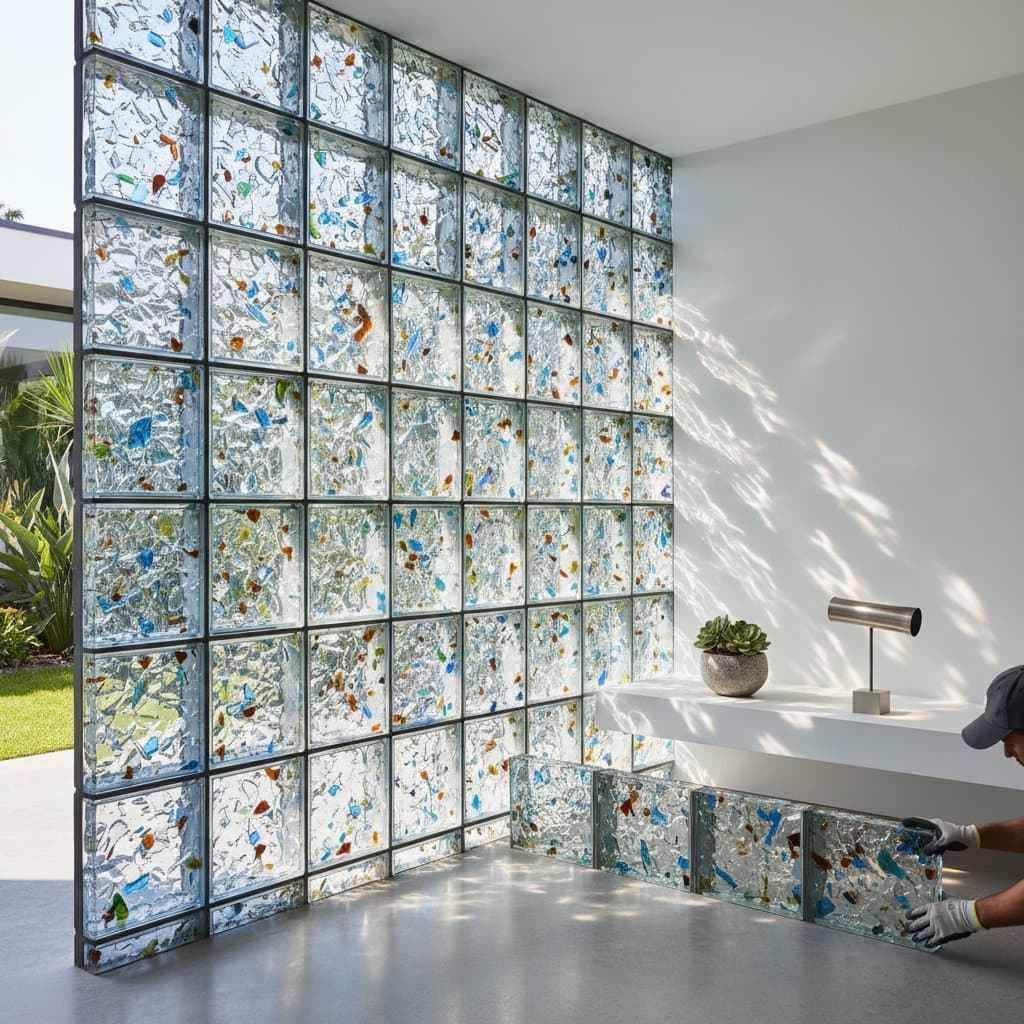5. Complete the Top Course and Joints
Reach the planned height for your structure. Employ a jointing tool to refine the mortar lines, creating clean, uniform finishes. Contour the uppermost surface with a gentle slope to direct rainwater away from the assembly. Allow the entire installation to cure completely, typically over 24 to 48 hours depending on ambient conditions.
Quality verification: Inspect for absence of gaps or irregular alignments in the joints.
Practical advice: Wipe the glass surfaces with a lightly moistened sponge prior to the mortar's final hardening to achieve a polished appearance.
6. Apply Sealant for Protection
Following the full curing period, coat the assembly with a transparent sealant specifically formulated for glass-based masonry products. This treatment intensifies the material's hues, prevents stain accumulation, and shields the mortar joints against water penetration.
Importance of this step: Joints without sealant readily take in moisture, which can result in cracking from freeze-thaw cycles or unsightly fading over time.
To apply effectively, use a brush or low-pressure sprayer for even coverage. Focus on joints and exposed edges. Reapply every two to three years based on exposure to weather elements, ensuring long-term resilience.
Avoiding Pitfalls in Installation: Mistakes and Remedies
Even experienced builders encounter challenges with recycled glass masonry. Addressing issues promptly preserves the project's integrity and appearance.
- Irregular base preparation: An uneven footing produces crooked rows throughout the build. Remedy this by spreading a self-leveling compound across the foundation before placing the first course.
- Mortar mixture too stiff: Insufficient moisture in the mix weakens adhesion between units. Prepare mortar to the texture of smooth peanut butter for optimal workability and strength.
- Imprecise cutting of units: Excessive trimming wastes resources and interrupts the consistent pattern of joints. Measure each cut meticulously and secure a guide fence on your cutting tool for accuracy.
- Omitting the sealant application: This oversight invites water damage into the structure. Wait until curing completes, then apply the specified protective coating.
- Neglecting joints for expansion: In extended walls, omit control joints at intervals of four to six feet to allow for thermal movement without stress fractures.
Should any portion of the wall displace or develop cracks, carefully extract the affected units. Clean the contact surfaces thoroughly, then reposition them using newly mixed mortar. Minor surface imperfections, such as small chips on glass edges, respond well to polishing with fine-grit sandpaper or filling with a color-matched epoxy resin for seamless repair.
Expanding on these fixes, consider environmental factors during installation. In humid climates, extend curing times to prevent premature weakening. For seismic zones, incorporate flexible joint materials to enhance overall stability.
Upkeep Strategies for Recycled Glass Masonry
Recycled glass masonry demands routine maintenance to sustain its visual clarity and structural soundness. Regular inspections reveal potential issues before they escalate.
Trim nearby plants to prevent root growth or vine adhesion that could exert pressure on the units. Steer clear of de-icing chemicals in proximity to the installation, as their corrosive nature etches glass surfaces and dulls the finish.
In winter months, examine the sealant layers for cracks or peeling. Refresh the coating as necessary to maintain a waterproof barrier. For indoor applications, select mild, non-abrasive cleaning agents to clean the glass without scratching.
Outdoor features benefit from occasional rinsing with a garden hose to remove accumulated dirt and pollen. Should a white, powdery residue known as efflorescence form on the surface, prepare a solution of equal parts white vinegar and water. Apply it gently with a soft brush, then rinse with clean water to restore the original luster.
Beyond basic cleaning, monitor for settling in the foundation annually. Adjust as needed to keep the structure plumb. These practices extend the lifespan of your masonry, often beyond two decades with proper care.
Integrating Recycled Glass Masonry into Sustainable Projects
Recycled glass masonry merges visual elegance, environmental stewardship, and practical utility in a manner that surpasses many conventional options. It diffuses natural light through its translucent properties, repurposes industrial byproducts, and diminishes the environmental impact of building activities.
Incorporate this material into garden enclosures, boundary walls, or light-permeable partitions to elevate both form and function. Each installation advances broader goals of resource conservation while delivering a unique, reflective quality to spaces.
Plan your project with attention to site-specific conditions, adherence to building codes, and innovative design elements. Through such efforts, recycled glass masonry not only outperforms traditional bricks in sustainability and aesthetics but also fosters enduring value in every application.
